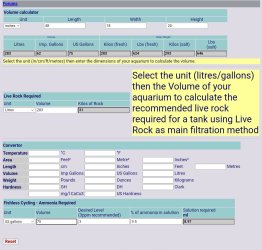Dr. Tim is a scientist. They use a different scale in science than we do in the hobby. Science uses the Nitrogen scale and we in the hobby normally use the Total Ion scale. Science is mostly interested in the Nitrogen so they only measure that. So lets ;ppl at the three things we measure at the cycle:
Ammonia is NH3
Ammonium is NH4
Nitrite is NO2
Nitrate is NO3
As you can see all of these things contain one N so the scientist sees them as all being equal. But in the hobby we use the Total Ion (TI) scale and that counts the Hs and Os.
There are two major ways to describe the concentrations of ammonia, nitrite, and nitrate in water. The "nitrogen" weight of these molecules describes the weight of only the nitrogen atoms within them. On the other hand, the "ion" weight of these molecules describes the weight of the entire molecule.
For example, the term nitrate-nitrogen (NO3-N) refers to the weight of only the nitrogen atom within the nitrate molecule; as opposed to nitrate-ion (NO3), which describes the weight of the entire nitrate molecule. Note that a given nitrate-nitrogen value will always be lower than the associated nitrate-ion value. Conversion between the two forms is as simple as applying a constant (see graph below).
Scientific literature often uses the "nitrogen" form rather than the "ion" form to describe the concentration for these molecules. The "nitrogen" form is more appropriate when discussing nitrification/denitrification cycles, as it simplifies various equations and flow-charts. For example, it is easy to see that 100 ppm of nitrite-nitrogen (NO2-N) can go on to form 100 ppm of nitrate-nitrogen (NO3-N). Using the "ion" form here would be more cumbersome; 100 ppm of nitrite (NO2) goes on to form approximately 135 ppm of nitrate (NO3).
Note that a total ammonia value (NH3 + NH4) cannot be trivially converted from "nitrogen" to "ion" form or vice versa. The total ammonia value must first be broken into component NH3 and NH4 values, then those converted individually to NH3-N and NH4-N and added together. The Free Ammonia Calculator can be used to do this.
|
Conversion
| NH3 = NH3-N * 1.21589 |
| NH4 = NH4-N * 1.28786 |
| NO2 = NO2-N * 3.28443 |
| NO3 = NO3-N * 4.42664 |
Assumed atomic weights: H: 1.008, N: 14.007, O: 15.999
While science needs to be as accurate as possible, we have a bit of wiggle room in the hobby. Most of the Total Ammonia (TA) in a tank is in the form of Ammonium. At a pH of 6 or below the TA is virtually 100% ammonium. So I have come to use 1.28 as a reasonable value for Total Ammonia.
If one has 90% NH4 and 10% NH3 then you have (1.28786 x .9) + (1.21589 x .1) or 1.159074 + .12189 = 1.280964. As you can see 1.28 is close enough to 1.280964 or even 100% NH4 at 1.28786 to be a reasonable number to use for TA in general, imo.
So when Dr. Tim's Ammonium chloride is dosed to 2 ppm of ammonia-n, on an API type test kit that should read 2 x 1.28 or 2.56 ppm. It takes 4 drops/gal. of Dr. Tim's ammonium chloride to produce 2 ppm as nitrogen or 2.56 ppm on the Total Ion scale. Therefore if you are shooting for 3 ppm, add 5 drops/gal. 5 is 1.25 times the normal 4 drop dose. So that will produce 2 x 1.25 or 2.5 ppm as nitrogen or 2.5 x 1.28 or 3.2 ppm on the TI scale. That will give you a tad over the target 3 ppm but it is not over by much. You can still use the directions here. Depending on the gallons in your tank you may be able to get even closer to 3 ppm.
Of course, the fishless cycling article here does take into account the use of live plants or seeding a decent amount of bacteria- either a commercial product or taken from one's other tanks if one has them.
One last observation about ammonia dosing and fishless cylcling. As the cyle progresses and we establish eve increasing amounts of bacteria along the wa, this will effect the ammonia reading soon after we dose. When there ae a number of bacteria at work, as soon as we add ammonia they start to use it. So when we wait a bit to test after dosing,we wiil get very different readings on day one of a cycle v.s. day 35. On day 35 there are a large number of ammonia oxidizing bacteria ready to chow down as soon as the ammonia hits the water. So waiting 30 minutes gives them time to process a bunch of that 3 ppm and, when we test, the number will be clearly lower than 3 for sure.
The big advantage to using a product like Dr. im;'s ammonium chloride is we know exactly how much ammonia is should produce. So trust the dosing over the the testing to know you have added the correct amount.
 .
.




